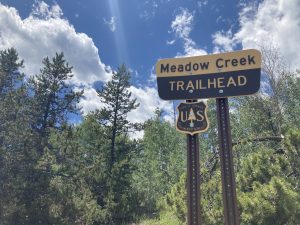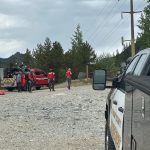Get Wild: Hard work brings improvements to Meadow Creek Trail
Get Wild

Nicole Miller/Summit Daily News
If you’ve hiked the Meadow Creek Trail, you know it’s been worn down by hikers and water. The steep sections were uneven and filled with boulders and gravel, making travel difficult. This year, that is being fixed by the U.S. Forest Service with help from Rocky Mountain Youth Corps and Eagle Summit Wilderness Alliance. Teams of workers are smoothing the trail bed and building 27 “check steps” to make the trail easier to hike, and more sustainable.
What is a check step? As the name implies, they are steps on the trail that check water flow and make hiking steep slopes easier. Each step is 12-inches high and the width of the trail, with a level landing 4-5 feet long. The level area is easier to hike, and also prevents erosion. During spring runoff, or after a heavy rain, water rolls off trail, rather than forming rivers that erode the trail.
So, how is a check step built? Each step has three major components. First, two timber beams form the foundation. Behind and around the beams, crushed rock and gravel stabilize the beams, creating a level landing behind the step. Finally, dirt (technically mineral soil) is spread over the crush to create a smooth, level trail bed. These three components take a team of laborers about a day to construct each step.
The timber portion of the step begins with volunteers carrying two huge timbers to the site of the step. Each 8-by-8-inch-by-12-foot timber requires 3-4 workers to carry it nearly a mile up the Meadow Creek Trail. Workers dig notches into the side of the trail to hold the timbers. Between the notches, workers dig a 6-inch trench across the trail to provide a level foundation for the timber step. Then, crushed gravel is placed in the trench.
The first timber will then be placed in the trench, and leveled front to back and left to right. Previously a worker has drilled two holes into this timber, and now a long rebar is pounded through the timber to secure the timber to the ground. If the workers are lucky, the rebar doesn’t hit a buried boulder. Then, the second timber is placed on top of the first. With a long drill bit, three holes are drilled for more rebar. Once that rebar is pounded through the two timbers, you have the front of a 12-inch step, and it’s probably time for lunch.
All along, other workers have been gathering small boulders and rock to pound into “crush” with sledgehammers. A lot of crush is needed to level timbers, stabilize the steps, and provide the landing behind the step. Workers in the “crush factory” spend the day pounding at rocks until they shatter into the required golf-ball-sized pieces. At the crushing factory, rock shards are flying everywhere, and personal protection, glasses and hardhats are required. Boulders are carried in from the forest, gravel gathered from the trail, and crushed rock is carried to the step and spread to level out the landing.
Finally, mineral soil is spread over the crush, blending step with the rest of the trail bed. Another set of workers dig the soil from the ground and carry it in dirt bags to the step. Once that is spread and tamped down, the step is done — only 26 more to go.
The revived Meadow Creek Trail should be open in August. Go admire the work.
Jim Alexander is a Silverthorne resident whose work with the Eagle Summit Wilderness Alliance includes leading both the WeedSpotter program and grant program, which funds several wilderness projects. Jim is also Eagle Summit Wilderness Alliance’s representative on the State Noxious Weed Advisory Committee.


Support Local Journalism

Support Local Journalism
As a Summit Daily News reader, you make our work possible.
Summit Daily is embarking on a multiyear project to digitize its archives going back to 1989 and make them available to the public in partnership with the Colorado Historic Newspapers Collection. The full project is expected to cost about $165,000. All donations made in 2023 will go directly toward this project.
Every contribution, no matter the size, will make a difference.









